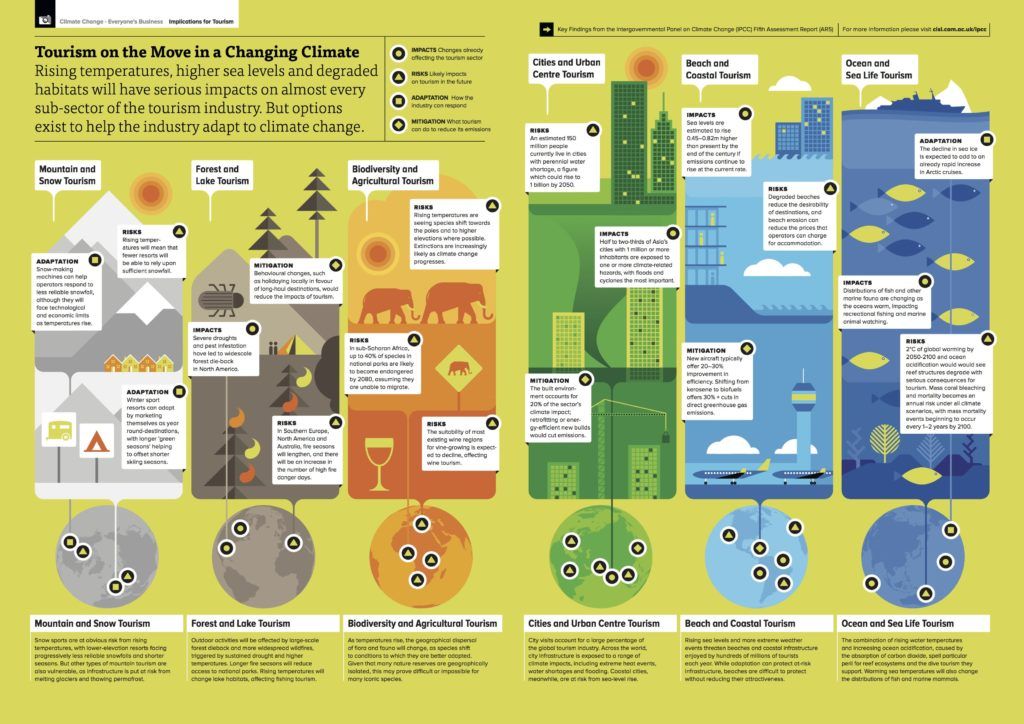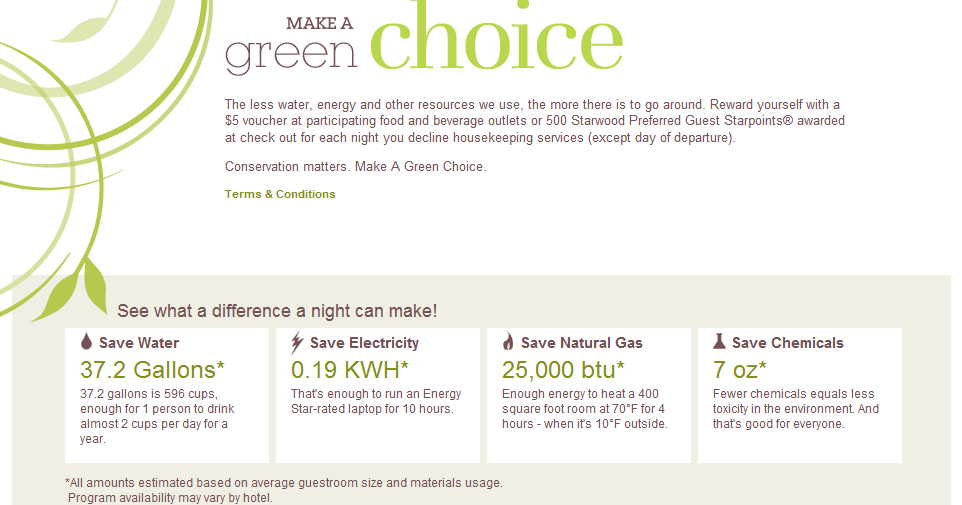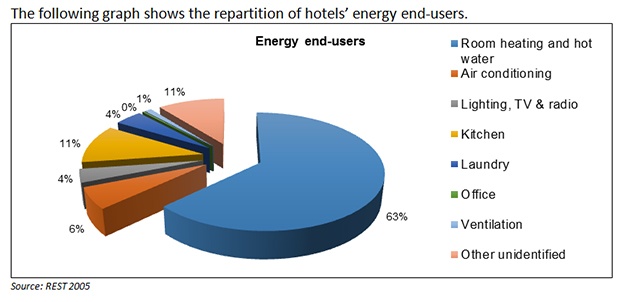Hospitality in an increasingly inhospitable world

A look into what Starwood Hotels & Resorts has done in light of climate change.
Among the different industries involved in tourism, hospitality is particularly vulnerable to climate change given the relatively high volume of fixed assets in locations that will suffer the most from erratic weather and seasonal changes. Coastal and island destinations are increasingly exposed to dangers of rising sea levels, hurricanes, flooding, water shortages, and erosion. In cold-weather destinations, reduced snow cover and shorter winter seasons driven by global warming also negatively affect business performance. In addition to these direct impacts, climate change also indirectly affects the hospitality industry by damaging ecological biodiversity and changing natural landscapes.

However, it is also important to realize that the relationship between climate change and tourism is twofold. Though tourism benefits greatly from climate stability, it directly contributes to environmental issues through high energy consumption and waste generation. The contribution of tourism to greenhouse gas (GHG) emissions has been on the rise, projected to grow 130% between 2005 and 2035 [1]. Recent calculations estimate that tourism accounts for about 5% of global CO2 emissions – a fifth of which is generated by the hospitality industry [2].
Green Initiatives at Starwood Hotels & Resorts
Due to heavy consumption of resources, the hospitality industry is under mounting pressure to increase commitment to environmentally sustainable practices. Starwood Hotels & Resorts (which was recently acquired by Marriott [3]) is one of the hotel groups striving to reduce their carbon footprint and has pledged to cut carbon emissions by 30%, energy use by 30%, and water use by 20% between 2008 and 2020 globally [4]. By 2014, Starwood had successfully reduced carbon emissions by 16.07%, energy use by 12.08%, and water use by 17.26% across all owned, managed and franchised properties [4].

A third of the progress seen to date has been driven by “foundational” initiatives which are projected to save about $1 billion across the portfolio in less than 10 years [4]. These initiatives target low or no-cost operational and equipment improvements (such as replacing incandescent bulbs with high-efficiency LED lighting and installing low-flow toilets) that often pay for themselves within a year by boosting efficiency [5]. Foundational initiatives also focused on changing behavior, such as the successful “Make a Green Choice” program which rewards guests with loyalty program points when they decline housekeeping for up to three days in a row (excluding checkout day). Up to 49.2 gallons of water, 0.19 kWh of electricity, 25,000 BTU of natural gas, and 7 oz. of chemicals from cleaning products are saved each night of declining housekeeping [5].

While foundational initiatives will continue to generate savings and minimize environmental impact, most improvements are driven by capital-intensive investments (such as replacing old equipment, hotel renovations, and new construction) and technological innovations (such as harnessing solar energy on site) which have a substantial impact on overall energy usage. Energy in hotels (approximately 60% of a hotel’s CO2 emissions) is mainly consumed by temperature regulation, which represents on average 69% of energy consumption (63% for heating and hot water and 6% for air conditioning; see figure below) [6]. By undertaking in larger projects like re-engineering water heaters and installing control systems, the Sheraton Santa Fe in Mexico City was able to cut energy use by 26.1%, carbon emissions by 35.61% and water consumption by 39.33% [4].

Since it’s challenging for hotels to be truly green given the nature of their operations (e.g., 30%-70% of a hotel’s square footage is usually public space that needs to be lighted, cooled and heated), building environmentally efficient hotels can have a substantial reduction in overall energy usage [7]. In 2008, Starwood launched an eco-hotel brand, Element, and became the first major hotel brand requiring all of its properties to obtain the US Green Building Council’s LEED (Leadership in Energy and Environmental Design) certification [8]. LEED ranks buildings based on energy and atmosphere, site sustainability, efficient use of water and environmentally responsible materials in construction and maintenance. Element hotels also serve as “sustainability laboratories” for Starwood to pilot various innovations and initiatives [5] which will allow them to scale efficiently by spreading “tried-and-true” best practices across other hotel brands in the portfolio.
More opportunities ahead
The merger between Starwood and Marriott will likely provide more opportunities to expand environmental goals. Marriott has long been a leader in sustainability, working with developers to turn certain existing properties into LEED-certified buildings [7]. Marriott’s leadership team has also expressed interest in growing Starwood’s Element brand [3]. With combined scale and resources, the merged entity can consider pursuing even more capital-intensive and innovative initiatives such as:
- Employ passive house design (which uses ambient energy sources like natural ventilation, super-insulation) for new-build hotels
- Invest in retrofitting existing properties with more energy-efficient structures and equipment
- Invest in on-site, clean power generation and utilize building energy management programs
Word count: 785
Sources
3: “Marriott, Starwood merger is complete, loyalty programs will reciprocate”, USA Today, September 26, 2016



Very interesting post! While most large corporations have internal sustainability programs in place, Starwood is one of the few that is able to truly influence consumers to behave in a more “green” manner. The loyalty points program, compared to other customer-targeted initiatives that I’ve seen, offers particularly compelling incentives.
In regards to Element, I’d be curious to see the financial metrics of these hotels versus that of the traditional properties, so as to understand whether large-scale expansion of the eco-hotels portfolio makes sense for Marriott-Starwood from a bottom-line perspective. Furthermore, does Marriott, as a leader in sustainable hospitality, have its own brand of eco-hotels? If the answer is no, why do you think they haven’t pursued that option?
Great post; such a fun read! Like the commenter above, I find the loyalty points in exchange for guests acting greener to be particularly interesting. From a marketing angle, I wonder about efforts in the hospitality industry to brand and sell customers on eco-friendly practices. Do hotels face the same challenges that we saw in the Nike case, where sustainable and eco-friendly products were seen as being inferior? If so, how can we position Starwood and its competitors such that customers seek out the most eco-friendly hotels and resorts?
As a frequent user of the “Make a Green Choice” program, I can definitely testify to the benefits of a simple bit of customer behavior modification. That said, I find the point around Element, and wider integration with Marriott, to be especially interesting. I didn’t realize that Starwood was even using Element as such a test-bed for new ideas, but for such a large company (and as part of a much larger one now), that makes a ton of sense. What I think will be interesting going forward though, is also what risks the Marriott deal poses. Integrating climate management approaches will likely be seen as important, but I wonder if it’ll be at the top of the integration team’s agenda (especially with so much else on their plate). Hopefully the end result is that this effort doesn’t get derailed in the short-term, though I will profess to being a tad concerned.
As a loyal Starwood customer, it’s been fascinating to watch them roll out their sustainability and “green” initiatives. What’s interesting to me is the lack of consistency they have in their practices across geographical regions. Is there perhaps an opportunity for such a large and diverse hospitality industry to learn from some of the hotels within their portfolio? For example, the Starwood hotels in developing countries already need to deal with a lack of consistent and cheaply available electricity and clean water. As such, in addition to the loyalty points-based initiatives, many of them have completely different user experiences such as requiring a key card to turn on the electricity. As you’ve rightly mentioned, there is much to be done in the longer term via things like design or clean power management, but I wonder if they are ignoring some of the lowest hanging fruit.